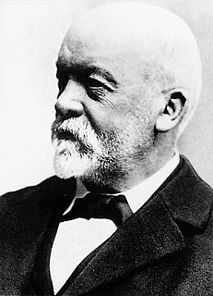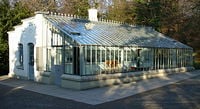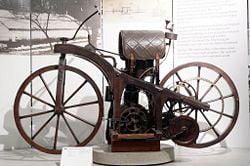Gottlieb Daimler
Gottlieb Wilhelm Daimler (March 17, 1834 - March 6, 1900) was an engineer, industrial designer, and industrialist, born in Schorndorf (Kingdom of Württemberg), in what is now Germany. He was a pioneer of internal-combustion engines and automobile development.
Daimler and his lifelong business partner, Wilhelm Maybach, were two inventors whose dream was to create small, high speed engines to be mounted in any kind of locomotion device. They patented, in 1885, a precursor of the modern petrol engine, which they subsequently fitted to a two-wheeler, considered the first motorcycle and, in the next year, to a stagecoach, and a boat. They are renowned as the inventors of this Grandfather Clock engine.
Later, in 1890, they founded Daimler Motoren Gesellschaft (DMG). They sold their first automobile in 1892. Daimler fell ill taking a break from the company and upon his return experienced difficulty with the other stock holders, which led to his resignation in 1893, later reversed in 1894. Soon Maybach resigned also and he returned at the same time as Daimler. In 1900, Daimler died, and Maybach quit DMG in 1907. In 1924, the DMG management signed a long term cooperation agreement with Karl Benz's Benz & Cie., and in 1926, the two companies merged to become Daimler-Benz AG, which is now part of Daimler Chrysler.
As one of several men who shared in the invention of the motor car, Daimler left his mark on the world, helping to radically improve transport and communications across the globe. Renowned for his hard-work and precision, and, according to one commentator, he made the "automobile revolution possible:" "Daimler was an engineer with a peerless ability to synthesize ideas others had developed before and to create something better." "That spirit," writes Wernie, "lives still in the" automobile "industry today."[1].
Early life (1834 to 1852)
Gottlieb Wilhelm Daimler was the son of a baker named Johannes Däumler (Daimler) and his wife Frederika, from the town of Schorndorf near Stuttgart, Württemberg. By the age of thirteen (1847), he had completed his six years of primary studies in Lateinschule, where he had also had additional drawing lessons on Sundays and expressed an interest in engineering. The next year, he started studying gunsmithing; building with his teacher, Riedel, a double-barreled gun.
Again, Daimler became restless in his studies, as his main interest still lay in engineering. In 1852, when eighteen, he finally decided to take up mechanical engineering, and left his hometown.
Career beginnings and Maybach
Gottlieb Daimler took up his first mechanical engineering work in industry at Graffenstaden, but abandoned it in 1857, to begin studies at the Stuttgart Polytechnic.
After this, Daimler traveled through several European countries. In France, he studied the novel gas engine of J. J. Lenoir and also worked in other factories, including one in Strasbourg, which made locomotives, and in another, which made band saws.
In the United Kingdom, Daimler helped start engineering works in Oldham, Leeds, and Manchester (with Joseph Whitworth). Later, he also worked in Belgium. Finally, he returned to Germany, working as technical designer in a metal factory at Geislingen an der Steige, with the father of his friend Heinrich Straub.
At twenty-nine years old, in 1863, Daimler started in a special factory, a Bruderhaus in Reutlingen. It had charitable purposes, with a staff made up of orphans, invalids, and poor people. One of the orphans was Wilhelm Maybach, a qualified Industrial designer aged nineteen years who would become his lifelong partner.
In his free time Daimler had fun designing machinery, agricultural equipment, and also some scales. In 1867, he married Emma Kunz, a pharmacist's daughter. They were to have five sons, among whom was Paul Daimler.
In 1869, at thirty-five, Daimler moved to Karlsruhe, to work at the engineering manufacturer, Maschinenbau-Gesellschaft Karlsruhe AG. Six months later, Maybach joined him as Technical Designer. Both inventors spent long nights discussing new designs for engines for pumps, lumber industries, and metal pressing.
The Otto Four-Stroke engine (1876)
In 1872 (at age thirty-eight), Gottlieb Daimler and Maybach moved to work at the world's largest manufacturer of stationary engines of the time, the Deutz-AG-Gasmotorenfabrik in Cologne. It was half-owned by Nikolaus August Otto, who was looking for a new technical director. As directors, both Daimler and Otto focused on gas-engine development while Maybach was chief designer.
In 1876, Otto invented the Four-stroke cycle, also known as the Otto Cycle, a system characterized by four piston strokes (intake, compression, power, and exhaust). Otto intended that his invention would replace the steam engines predominant in those years, even though his engine was still primitive and inefficient. Otto's engine was patented in 1877, but the patent was soon challenged and overturned. Unknown to Otto, Daimler, and Maybach, in Mannheim, during 1878, Karl Benz was concentrating all his efforts on creating a reliable two-stroke gas engine based on the same principle. Benz finished his engine on December 31, 1878, New Year's Eve, and was granted a patent for his engine in 1879.
Meanwhile, serious personal differences arose between Daimler and Otto, reportedly with Otto being jealous of Daimler, because of his university background and knowledge. Daimler was fired in 1880, receiving 112,000 Gold-marks in Deutz-AG shares in compensation for the patents of both Daimler and Maybach. Maybach resigned later.
Daimler Motors: small, high speed engines (1882)
After leaving Deutz-AG, Daimler and Maybach began to work together. In 1882, they moved back to Stuttgart in Southern Germany, purchasing a cottage in Cannstatt's Taubenheimstrasse, with 75,000 Gold marks from the compensation from Deutz-AG. In the garden, they added a brick extension to the roomy glass-fronted summerhouse and this became their workshop. Eventually, their activities alarmed the neighbors, who called the police and reported them as suspected counterfeiters. The police obtained a key from their gardener and raided the house in their absence, but found only engines.
In 1890, Daimler Motoren Gesellschaft (Daimler Engines Company) or DMG, was founded with Maybach as chief designer. Its purpose was the construction of small, high speed engines for use on land, water, and air transport. The three uses is the basis for the modern Mercedes-Benz logo of a three-pointed star.
Daimler and Maybach spent long hours debating how best to fuel Otto's Four-Stroke design, and turned to a byproduct of petroleum. The main distillates of petroleum at the time were lubricating oil, Kerosene (burned as lamp fuel), and Benzene (now known as Gasoline, or Petrol), which up to then was used mainly as a cleaner and was sold in pharmacies.
The Grandfather Clock Engine (1885)
In late 1885, Daimler and Maybach developed the first of their engines, which is often considered the precursor of all modern petrol engines. It featured:
- a single horizontal cylinder
- air cooling
- large cast iron flywheel
- hot tube ignition system
- cam operated exhaust valves, allowing high speed operation
- 600 rpm running speed, beating previous engines which typically ran at about 120 to 180 rpm
In 1885, they created a carburetor, which mixed gasoline with air, allowing its use as fuel. In the same year, Daimler and Maybach assembled a larger version of their engine, still relatively compact, but now with a vertical cylinder of 100 cm² displacement and an output of 1 hp at 600 rpm (patent DRP-28-022: "non-cooled, heat insulated engine with unregulated hot-tube ignition"). It was baptized the Grandfather Clock (Standuhr), because Daimler thought that it resembled an old pendulum clock. This is probably the same internal-combustion engine referred to by American author and historian Henry Adams, who, in his autobiography, describes the "Daimler motor" (Kolocotroni, Goldman and Taxidou 42) at the Paris Exposition of 1910 (Kolocotroni, Goldman and Taxidou 41).
In November 1885, Daimler installed a smaller version of this engine in a wooden bicycle, creating the first motorcycle (Patent 36-423impff & Sohn "Vehicle with gas or petroleum drive machine"). It was named the "riding car" ("Reitwagen"). Maybach rode it for 3 kilometers alongside the river Neckar, from Cannstatt to Untertürkheim, reaching 12 km/h (7 mph).
Also in 1885, Karl Benz built a three wheeled automobile and was granted a patent for it dated January 29, 1886.
On March 8, 1886, Daimler and Maybach secretly brought a stagecoach made by Wilhelm Wafter to the house, telling the neighbors that it was a birthday gift for Mrs. Daimler. Maybach supervised the installation of a larger 1.5 hp version of the Grandfather Clock engine into this and it became the first four wheeled vehicle to reach 16 km/h (10 mph). The engine power was transmitted by a set of belts. Like the motor cycle, it also was tested on the road to Untertürkheim, where present day Gottlieb-Daimler-Stadion is situated.
Daimler and Maybach also used the engine in other types of transport including:
- On water (1887), by mounting it in a 4.5 meters long boat and achieving a speed of 6 knots (11 km/h). The boat was called the Neckar after the river it was tested on. Boat engines would become Daimler's main product for several years.
- Street-cars and trolleys.
- In the air, in Daimler's balloon, usually regarded as the first airship, where it replaced a hand-operated-engine designed by a Dr. Friedrich Hermann Woelfert from Leipzig. With the new engine, Daimler successfully flew over Seelberg on August 10, 1888.
They sold their first foreign licenses for engines in 1887, and Maybach went as company representative to the Paris World's Fair (1886 to 1889), to show their achievements.
First Daimler-Maybach automobile (1889)
| high speed four-stroke petrol engine | |
|---|---|
| fuel vaporization | |
| 2 cylinders V-configured | |
| mushroom shaped valves | |
| water-cooled | |
| 4 speed toothed gearbox | |
| pioneer axle-pivot steering system | |
Engine sales increased, mostly for boat use, and in June 1887, Daimler bought another property at Seelberg hill, Cannstatt. It was located some distance from the town, on Ludwigstraße 67 because Cannstatt's mayor did not approve of the workshop, which cost 30,200 gold marks. The new premises had room for twenty-three employees and Daimler managed the commercial issues while Maybach ran the Design Department.
In 1889, Daimler and Maybach built their first automobile that did not involve adapting a horse drawn carriage with their engine, but was somewhat influenced by bicycle designs. There was no production in Germany, but it was licensed to be built in France and presented to the public in Paris in October 1889, by both inventors. The same year, Daimler's wife, Emma Kunz, died.
Gottlieb Daimler's "pact with the devil" and the Phoenix engine (1890 to 1900)
Daimler and Maybach were struggling financially with the company. They were not selling enough engines or making enough money from their patents. Two financiers and munitions makers, Max Von Duttenhofer and William Lorenz, along with the influential banker Kilian Steiner agreed to inject some capital and converted the company on November 28, 1890, into a public corporation named the Daimler Motoren Gesellschaft, DMG.
Many German historians consider that this was Daimler's "pact with the devil," because it resulted in his loss of control over the company. [2]. DMG expanded, but it changed. The newcomers, not believing in automobile production, ordered the creation of additional stationary building capacity, and also considered merging DMG with Otto's Deutz-AG.
Daimler and Maybach preferred plans to produce automobiles and reacted against Duttenhofer and Lorenz. Maybach was denied a seat on the Board and on February 11, 1891, left the company. He continued his design work as a freelance in Cannstatt from his own house, with Daimler's support, moving to the closed Hermann Hotel in the autumn of 1892, using its ballroom and winter garden, employing twelve workers and five apprentices.
Finally—in 1892—DMG sold its first automobile. Gottlieb Daimler, at age fifty-eight, had heart problems and suffered a collapse in the winter of 1892/1893. His doctor prescribed a trip to Florence, Italy, where he met Lina Hartmann, a widow twenty-two years his junior, and owner of the hotel where he was staying. They married on July 8, 1893, honeymooning in Chicago during its World Fair.
The disputes with Lorenz continued. Daimler attempted to buy 102 extra shares to get a majority holding, but was forced out of his post as technical director. The company also was in debt to the amount of 400,000 gold marks and the other directors threatened to declare bankruptcy if Daimler didn't sell them all his shares and all his personal patent rights from the previous thirty years. Daimler accepted the option, receiving 66,666 Gold-marks, resigning in 1893.
In 1894, at the Hermann Hotel, Maybach, together with Daimler and his son Paul designed a third engine called the Phoenix and had DMG make it. It featured:
- Four cylinders cast in one block arranged vertically and parallel
- Camshaft operated exhaust valves
- A spray nozzle carburetor
- An improved belt drive system
It became famous around the world and, when fitted to a car, it won the petrol engine category of the first car race in history, the Paris to Rouen 1894.
The ill defined relationship between the inventors and DMG harmed the image of DMG's technical department. This continued until, during 1894, when the British industrialist Fredrick Simms made it a condition of his 350,000 mark purchase of a Phoenix engine license, which would stabilize the company finances, that Daimler, now aged sixty, should return to DMG. Gottlieb Daimler received 200,000 gold marks in shares, plus a 100,000 bonus. Simms received the right to use the Daimler brand name. In 1895, the year DMG assembled its 1000th engine, Maybach also returned as chief engineer, receiving 30,000 in shares.
During this period, their agreed licenses to build Daimler engines around the world included:
- France, from 1890, by Panhard & Levassor and Peugeot
- U.S., from 1891, by Steinway, the German piano maker
- United Kingdom, from 1896, by Frederick Simms as his Daimler Motor Company
- Austria, by Austro Daimler
Daimler died in 1900 and in 1907, Maybach resigned from DMG. In 1918, discussions With DMG about collaboration were initiated by Karl Benz, but rejected by the managers. In 1924, they resumed, and an agreement was reached that shared resources but provided for the production of separate brands. In 1924 a merger took place for a new company, Daimler-Benz, that led to a new brand name for the products produced by both, Mercedes-Benz. Daimler-Benz merged with Chrysler in 1999, resulting in Daimler-Chrysler.
Legacy
While Daimler did not invent the automobile, he did much to help make it commercially viable. He can, however, be credited with launching the automotive industry, alongside Karl Benz. Gurney Goldsworthy had tried and failed in this task. Daimler's most significant and enduring contribution lay in his insistence on precision and on maintaining standards. He "instituted a system of inspections" to ensure quality of production. [3]. The company he co-founded continues to produce cars of a high technical standard. The internal combustion engine which he helped to develop has had its negative aspects in terms of its impact on the environment. However, it has also revolutionized travel and communications and has helped to make people around the globe more aware of their common humanity and co-responsibility.
Notes
- ↑ Bradford Wernie, The workaholic who made the automotive revolution possible.
- ↑ Von Georg Etscheit, Der Tüftler im Glashaus. Retrieved September 11, 2007.
- ↑ Wernie
ReferencesISBN links support NWE through referral fees
- Bird, Anthony and Gottlieb Daimler. Gottlieb Daimler, Inventor of the Motor Engine. London: Weidenfeld & Nicolson, 1962.
- Dineen, Jacqueline and Gary Rees. Twenty Inventors. Twenty names. New York: M. Cavendish, 1988. ISBN 978-0863079696
- Norbye, Jan P. "Daimler, Gottlieb Wilhelm (1834-1900)" in An Historical Who's Who of the Automotive Industry in Europe. Jefferson, NC: McFarland & Co, 2006. ISBN 978-0786412839
- Wymer, Norman. Gottlieb Daimler. Lives of Great Men & Women. Oxford University Press, 1957.
External links
All links retrieved June 27, 2017.
Credits
New World Encyclopedia writers and editors rewrote and completed the Wikipedia article in accordance with New World Encyclopedia standards. This article abides by terms of the Creative Commons CC-by-sa 3.0 License (CC-by-sa), which may be used and disseminated with proper attribution. Credit is due under the terms of this license that can reference both the New World Encyclopedia contributors and the selfless volunteer contributors of the Wikimedia Foundation. To cite this article click here for a list of acceptable citing formats.The history of earlier contributions by wikipedians is accessible to researchers here:
The history of this article since it was imported to New World Encyclopedia:
Note: Some restrictions may apply to use of individual images which are separately licensed.


